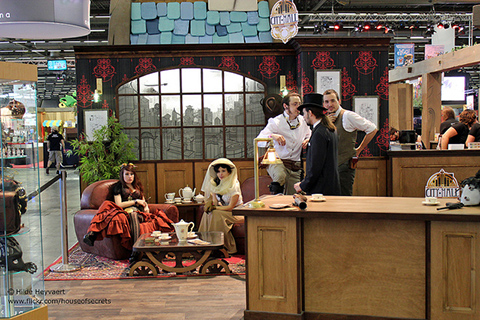
As steampunk becomes more recognized, moving further into the mainstream, questions have arisen concerning the nature of the genre and, pertinently in these politically tense times, its political persuasion, if any.
The possible political aspects of steampunk have led to heated discussion on a number of fronts, given impetus by the recent furor and allegations of racism over the “Victorientalism” issue of this Gatehouse Gazette and the arrest of Professor Calamity (or Elliot Madison) during the G20 protests in October 2009, with ensuing claims and counter-claims of Calamity being a “steampunk activist.”
This latter issue is complicated by the multifaceted nature of Calamity’s identity as an anarchist, journalist, social worker, volunteer advisor on legal issues to protestors as well as a steampunk.
This multifaceted nature of Professor Calamity is mirrored in the nature of steampunk itself.
As has been highlighted elsewhere, steampunk has contained a radical element since the beginning and has retained this through its various forms of expression — it has certainly never laid claim to be mainstream.
However, the nature of this radicalism is disparate and different “wings” of the steampunk genre have an uneasy relationship with each other.
Note that I am not using the term “movement” here, as this would give the impression of a combined and united group dedicated toward a single, or set, of goal(s), which, as steampunks themselves recognize, steampunk is not.
Definitions
This disparateness is readily seen in the myriad definitions of steampunk, many of which contain similar elements, but whose foci are slightly different to each other.
Indeed, those that dare to define steampunk upon their blogs or in their writings are lauded for their brave effort while often also being provided with suggestions for improvements to their definitions to include elements which they had otherwise omitted.
There are as many definitions of steampunk as there are steampunks and while this is no bad thing, given that the genre is self-driven, expressed in individual fashion by its protagonists, with no agreed leadership, it has the unintended consequence of exaggerating the problems which arise when the steampunk and non-steampunk world meet.
This can be readily seen in the police handling of the Calamity case. Given the nature of his wider activities as an anarchist, and against the normative background of the “War on Terror”, the local police had a different perception to a steampunk of the gas masks which were found in Calamity’s apartment upon their search.
It may also be seen in academic circles, whereby external researchers who have started to approach the genre of steampunk from within their academic disciplines — notably fiction studies — have been struggling to firmly identify what it is that they are studying.
The lack of cohesiveness within the steampunk genre itself contributes to the misunderstanding on the part of non-steampunks as to what steampunk is and what it is not, as well as hampering effective discourse within the genre itself.
Utopianism
One approach which may address these issues is through utopianism and an understanding of steampunk as an expression of utopia.
Within utopian studies, there is an understanding that, while utopists (those who study utopia) may not agree upon a definition of utopia, this is not a barrier to effective discussion and mutual understanding.
The study of utopia, and utopianism, is disparate and multidisciplinary, covering fields as diverse, for instance, as literature, architecture, politics, history, geography, music and fashion, and spanning the spectrum from authoritarianism through liberalism to anarchism, and steampunk maps very well onto this.
Like the worlds that steampunk envisages, utopia is “the good place that is no place.” A paradox emerges from Thomas More’s (who invented the term in 1516) etymological and phonetic play on three Greek terms: eu (good), ou (non or not) and topos (place).
Steampunk similarly combines criticism with creativity, disrupting familiar concepts and practices, and creating spaces in which alternatives can be imagined and explored.
Utopia, like steampunk, is critical in a constructive manner, acting as a mirror to the contemporaneous world and revealing the familiar to be strange. Both steampunk and utopia suggest that commonplace, universally accepted “truths” might actually be just conventions and that things do not have to be this way.
A better world
Utopias in all their forms (including dystopias) are restless, shifting phenomena, resistant to tidy conceptualization, reflecting the messy, complex and contradictory nature of human desires for a better world. Utopia can be simultaneously radical and authoritarian, liberating and restricting, exciting and frustrating — as can steampunk.
Utopianism articulates dissatisfaction with the now and desire for a better way of living, often situated in the future. Steampunk expresses dissatisfaction with the now, arising from a dissatisfaction of the past, and the desire for a better today.
Utopias depict, or suggest the hope for, better lives, and better worlds, and allow their author — whether of written fiction, a physical structure, or community — to show what they believe to be wrong with society and to demonstrate their imagined alternatives.
In fictional utopias, these moments of criticism and imagining alternatives often occur concurrently and this mechanism is seen in much steampunk literature: as the protagonist experiences new ways of doing things, they come to see the flaws in their own world. As the protagonist of Utopia comes to appreciate what is wrong with his own society through his experiences of the island society of Utopia, so do the protagonists of, for instance, Whitechapel Gods and the dystopian world of an alternative London.
Social dreaming
Utopianism has been studied through various means, providing different ways of understanding utopia through form, content and function, and includes utopia as literature (including myth), “real world” communities and social theory.
One key definition of utopianism (by Lyman Tower Sargent) which has framed the discourse perceives utopianism as a broad, general phenomenon of social dreaming: the dreams and nightmares that concern the ways in which groups of people arrange their lives and which usually envision a radically different society than the one in which the dreamers live.
This seems to reflect the steampunk genre well and is demonstrated particularly in steampunk role-play and in the online communities which form a core of the steampunk genre.
This social dreaming enables steampunks to imagine, for instance, an alternative nineteenth-century world of advanced steam-powered technology, or of racial harmony, not by betraying or washing away the stains of all that was wrong with nineteenth-century society, but by engaging with those problems in a constructively critical manner.
Rarely are utopias fully realized perfect societies, whether in written form or in the “real” world as utopian communal experiments, but they encompass the desire for a better, alternative way of living, and steampunk encompasses a desire for a better, alternative past.
Perfect society
There remains much distrust of utopia and utopianism, with the concept of utopia itself being an ideological battleground with no single agreed definition of “utopia” or “utopian”.
Partly this stems from the rise of the Soviet Union and utopia, in the twentieth century, did not have many friends. The collapse of the Soviet bloc between 1989 and 1992 prompted much to be made at the time of the defeat of utopia.
However, this was based upon a narrow understanding of utopia as “the” perfect society, which understood utopia as necessarily authoritarian and restricting. Strategies on the part of utopists and utopians in coping with this attack were varied, some limiting their definition of utopia and others countering that the central criticism of the anti-utopians — that the core of utopia is perfectibility — was flawed.
Within the steampunk genre there remains mistrust, often stemming from an individual’s non-recognition of another’s understanding of steampunk. Individuals within steampunk have their own understandings of what steampunk is and how a steampunk life should be lived, and while this vision may be only partially envisaged, steampunks hold certain understandings and beliefs in common in a way which should enable them to recognize each other and to come together in communities, whether in the real world as local groups, as societies, on discussion boards online or even as musicians to explore the unbounded field of steampunk music.
There is no understanding of “the” steampunk way of expression, just as there is no “the” utopia. Steampunk is a wide and varied genre and this powers its vitality and its crucial critical element, enabling it to remain radical without becoming narrowly politically focused and for its protagonists to act within the genre, it is to be hoped, without fear of retribution or harsh treatment from others within the genre for their views and practices of steampunk. An understanding of steampunk as utopian expression would allow this.
This story first appeared in Gatehouse Gazette 12 (May 2010), p. 9-10, with the headline “Steampunk — An Utopian Expression?”




